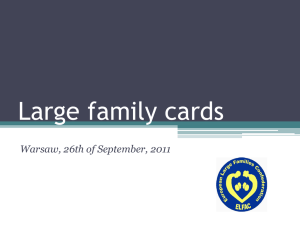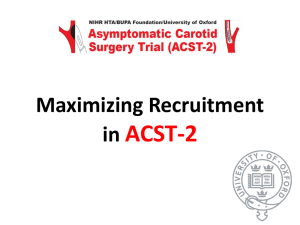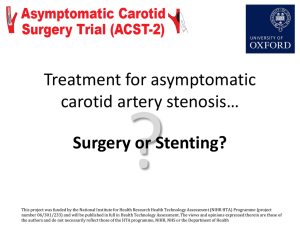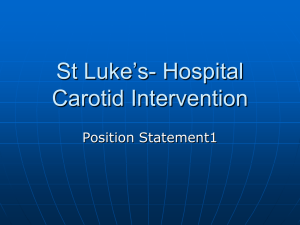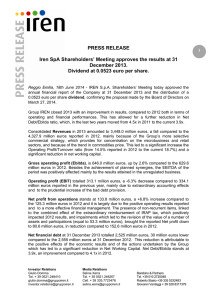Ophthalmic sub-study update - ACST-2
advertisement
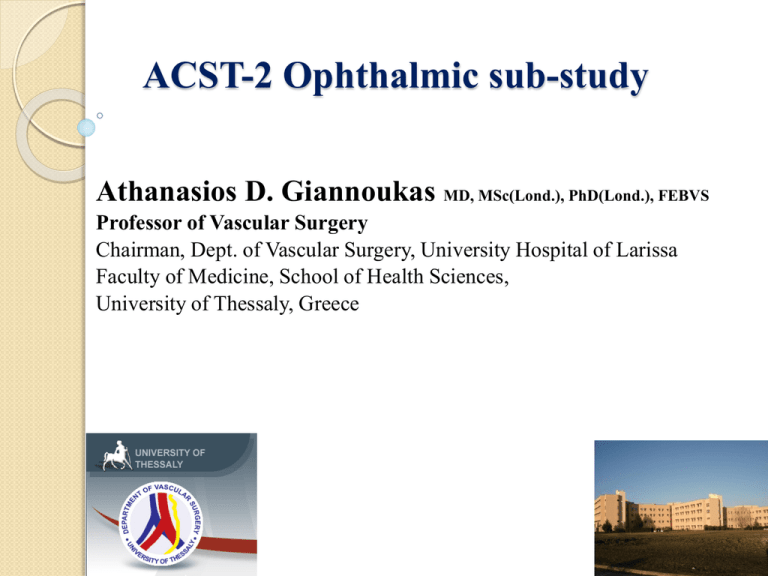
ACST-2 Ophthalmic sub-study Athanasios D. Giannoukas MD, MSc(Lond.), PhD(Lond.), FEBVS Professor of Vascular Surgery Chairman, Dept. of Vascular Surgery, University Hospital of Larissa Faculty of Medicine, School of Health Sciences, University of Thessaly, Greece Carotid artery stenting (CAS) has emerged as an alternative therapeutic option to carotid endarterectomy (CEA) for the management of patients with carotid artery stenosis. Several multicentre randomized controlled trials (RCTs) have compared the efficacy of CAS vs. CEA The outcomes that have been consistently evaluated are transient ischemic attack (TIA), stroke and death and myocardial infarction Brain micro-embolisation Brain micro-embolisation is less in CEA as compared to CAS with distal filter protection devices or flow-reversal Gupta N et al. JVS 2011;53:316-22 Tedesco MM et al. JVS 2007;46:244-250 Brain micro-embolisation CAS is associated on TCD with: Particulate macro-embolisation Massive air embolisation Multiple micro-embolisation All causing reduction in middle cerebral blood flow Along with the presence of pre-procedural brain infarcts may predict patients at high-risk of adverse effects Ackerstaff R et al. JVS 2005;41:618-24 Ophthalmic insult/ embolisation Retinal embolization during CAS is not uncommon, and it occurs in both protected and unprotected procedures (detected by fundoscopy only). Most retinal emboli are clinically silent (visual field testing). Vos JA et al. CVIR 2010;33:714-9 Objectives The effects of Ophthalmic insult after carotid interventions (CAS or CEA) have never been investigated in a systematic manner In respect to asymptomatic disease in which the difference in the usually investigated outcomes (Stroke, TIA, MI, death) between CAS and CEA may be marginal Rationale of the Sub-study Visual acuity and visual function are important parameters of the quality of life of elderly patients Anxiety and depression may often accompany diseases of the eye and conditions associated with visual dysfunction Zhou C et al. Psychosom Res 2013;75:75-82 Thus, eye-related quality of life (temporary or permanent blindness resulting from embolization of atherosclerotic debris into the ophthalmic artery) is an important denominator in asymptomatic patients undergoing carotid revascularization Rationale of the Sub-study ACST-2 represents a unique opportunity to initiate an Ophthalmic ACST-2 substudy to investigate and compare the effects of CAS vs. CEA on the ophthalmic circulation and visual function Aim To investigate the insult of the ophthalmic circulation and the outcome in visual function in patients randomised in ACST-2 Trial Ophthalmic embolisation and visual outcome may be important surrogate endpoints on which CAS and CEA may be evaluated in asymptomatic carotid disease Methods Patients recruited for ACST-2 Trial will be subjected to: 1-3 days prior to intervention Visual field testing Colour flow Doppler assessment of OA and RA Bilateral Fundoscopy with a digital photography Bilateral Fluoroscein angiography (optional) Methods 2-3 days after intervention Colour flow Doppler assessment of OA and RA Bilateral Fundoscopy with a digital photography Bilateral Fluoroscein angiography (optional) 6 months after intervention Visual field testing Colour flow Doppler assessment of OA and RA Financial aspects Difficult to adapt to all health care systems in Europe In Greece Visual field testing (=20 euros) along with fundoscopy and digital photography = 70 euros Fluoroscein angiography = 150 euros OA and RA Doppler imaging = 50 euros Financial aspects 1st assessment = 270 euros (without FA = 120 euros) 2nd assessment = 250 euros (without FA = 100 euros) 3rd assessment = 70 euros Full total cost / patient = 590 euros (without FA = 290 euros) 1 Brain MRI = 237 euros Numbers needed Difficult to make power analysis due to lack of large scale observational studies Arguably based on brain embolisation data we assume that equally Retinal embolisation will be common phenomenon Probably 100 pts in each intervention arm (CEA vs CAS) will suffice Interim analysis and power calculation will be undertaken when 50 pts will be in each arm Thanks for the attention
